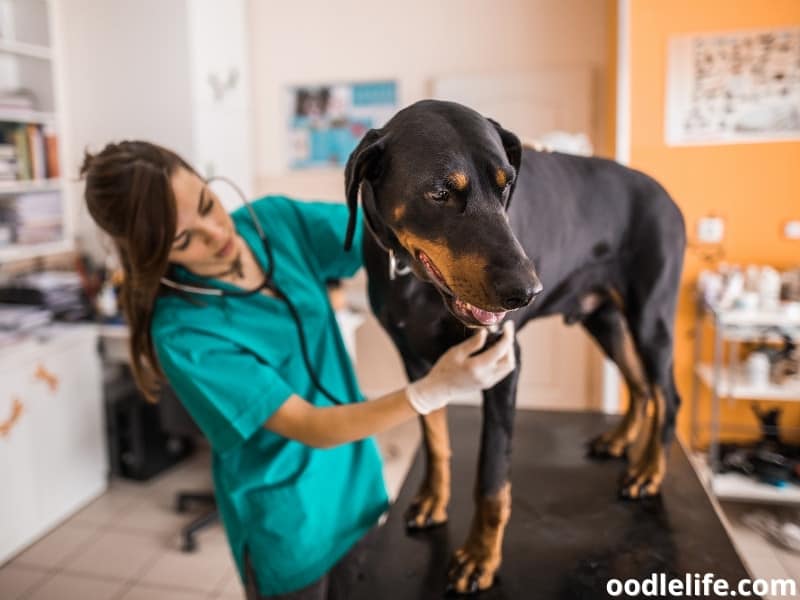Most likely, you’ve heard that two intact male dogs should not coexist. They wont get along. They will fight. They will both try to be the alpha.
Neutered male dogs might also fight. Or spayed females. Or unspayed females. There is a chance that dogs will fight if there are several.
But does having two healthy dogs make you more likely to get into fights? Probably not. There are plenty of other contributing factors to consider. Ages of both dogs. Breeds of both dogs. Temperament of both dogs. Behavior issues with one or both dogs.
You should take into account the statistics for such things if you want to reduce the likelihood of two household dogs fighting with one another. Neutering is just one of those. However, that one aspect by itself won’t reveal the risks.
As of this writing, Zooka and Blitzen are available. Zooka is an intact male Vizsla, two-and-a-half years old. Blitzen is an intact male Vizsla, one-and-a-half years old. Since Blitzen was about eight months old and for the last ten months, they have shared a home.
They have had plenty of tense moments. One gets upset about something, stiffens and growls. The other gets worried and also tenses up. Perhaps even growls back, although Blitzen usually does the growling.
In some cases, they manage to diffuse it themselves. Sometimes one of the humans in the house intervenes and directs them both to other locations where they can cool off.
No, not at this time. Would I trust that they won’t turn into a fight? The potential is there. But clearly neither one really wants to fight. By now there would have been a fight or several fights if one of them actually wanted to fight.
They occasionally find themselves in situations they are unsure of how to escape. So far, we have helped them out of those situations. It’s crucial to have an adult human intervene to maintain order. Someone who can remain composed and reassure them that there are other ways to diffuse that tense situation besides escalation
That brings up the remaining puzzle piece that we neglected to mention earlier. Whats that other factor? The humans.
How humans handle everything is a significant factor that can help to prevent fights from becoming a problem.
Many dog fights happen over resources. No, it’s not usually just one dog attempting to rule them all. One dog is attempting to protect what they see as a valuable resource. A bone. Food. A food bowl. A toy. A bed. A person. A doorway (access to it). That does not imply that they are attempting to rule everything and act as the alpha dog.
Some dogs are willing to fight over valuable resources. And your dog could decide anything is a valuable resource. Including you. (By the way, thats not protecting you. Thats keeping you all to himself. ).
Before everyone is sufficiently trained in the routine that they mind their own business, we separate the dogs for meals. It is never permitted to approach or make an attempt to take another person’s meal.
Our guidelines are clear: respect the other dog’s space and refrain from bothering or attempting to take away their chew toy.
We ask that everyone wait until they are let out through the door. Rules in place prevent them from making their own.
Furniture privileges? Only if you share and mind your manners. If not, you will be removed.
No, there are some dogs that will still fight despite the structure and rules. But with the right preparation and instruction, many issues can be avoided before they even arise.
Can two intact male dogs live together peacefully? Yes. But you need to know your dogs well. Additionally, you ought to exert all your efforts to keep potential problem areas from ever developing into issues. And be prepared to act if you start to notice problems emerging.
Do some intact male dogs simply struggle to coexist peacefully no matter what you do?
Neutering is just one factor to consider. There are a ton of additional factors that you must consider.
Gender matters with a second dog
There are, of course, exceptions to this rule, but in general, gender will be a major factor in how well your new dog gets along with your current dog.
For the greatest likelihood of success, experts concur that the second dog should be of the opposite sex.
Does Neutering Have an Impact on Their Relationship to One Another?
Although there are always exceptions to every rule, neutered male dogs are less likely to fight with other males. Even after being neutered, some male dogs may still act aggressively toward other males.
It really depends on the individual dog’s personality and history. It’s best to speak with a vet or animal behaviorist if you have concerns about your dog’s ability to get along with other male dogs.
However, neutering can generally assist in lowering male dog aggression and fighting. This is because testosterone plays a role in these behaviors. Because his testosterone levels are reduced after neutering, dogs tend to be calmer and more relaxed.
Neutering may be a great choice to think about if you have two male dogs that are fighting with one another. However, it’s crucial to remember that neutering doesn’t always stop canine aggression and disputes.
Before making any decisions regarding your dog’s behavior, it is always best to speak with a professional because many other factors may also be at play.

Reasons Two Male Dogs in the Same Household Fight
If you live with two male dogs, you may have noticed that they occasionally fight. There can be a number of reasons for this behavior.
It might be best to keep the dogs apart if you’ve tried everything and they still don’t get along.

FAQ
Is it better to have 2 male dogs?
Opposite sex dogs almost always work best together for the happiest dogs and the safest home. Dogs of the same sexes frequently engage in combat, sometimes to the death. There may not be much improvement for those who establish a dominance order.
Is it hard having 2 male dogs?
There will undoubtedly be conflict between the two males, even if your current dog is as sweet as can be. Things might go smoothly at first, but if they decide to switch the pack order later, they might be at each other’s throats. The two males might clash over toys and human attention as well.
Does gender matter when getting a second dog?
Although it is not a given that a female dog will make a better friend for a male dog, having dogs of the opposite sex is typically simpler and frequently safer if you have never had two dogs at the same time. The management of same-sex pairings can be challenging as dogs establish their dominance or pack hierarchy.
Can you have 2 male dogs from the same litter?
When two puppies from the same litter are adopted, the condition known as “littermate syndrome” frequently occurs. The puppies will bond with each other, which will decrease their likelihood of bonding with you. The dogs might not obey you and will be much more challenging to train.